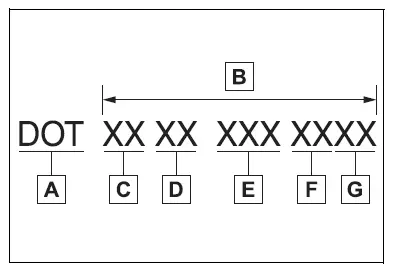Toyota Grand Highlander (AS10) 2024 Owners Manual / Vehicle specifications / Specifications / Tire information
Toyota Grand Highlander (AS10): Tire information
Typical tire symbols
Full-size tire

Compact spare tire

- Tire size
- DOT and Tire Identification Number (TIN)
- Location of treadwear indicators
- Tire ply composition and materials Plies are layers of rubber-coated parallel cords. Cords are the strands which form the plies in a tire.
- Radial tires or bias-ply tires A radial tire has "RADIAL" on the sidewall. A tire not marked "RADIAL" is a bias-ply tire.
- TUBELESS or TUBE TYPE A tubeless tire does not have a tube and air is directly put into the tire. A tube type tire has a tube inside the tire and the tube maintains the air pressure.
- Load limit at maximum cold tire inflation pressure
- Maximum cold tire inflation pressure This means the pressure to which a tire may be inflated.
- Uniform tire quality grading For details, see "Uniform Tire Quality Grading" that follows.
- Summer tires or all season tires An all season tire has "M+S" on the sidewall. A tire not marked "M+S" is a summer tire.
- "TEMPORARY USE ONLY" A compact spare tire is identified by the phrase "TEMPORARY USE ONLY" molded on its sidewall. This tire is designed for temporary emergency use only.
Typical DOT and Tire Identification Number (TIN)
Type A

- DOT symbol*
- Tire Identification Number (TIN)
- Tire manufacturer's identification mark
- Tire size code
- Manufacturer's optional tire type code (3 or 4 letters)
- Manufacturing week
- Manufacturing year
*: The DOT symbol certifies that the tire conforms to applicable Federal Motor Vehicle Safety Standards.
Type B

- DOT symbol*
- Tire Identification Number (TIN)
- Tire manufacturer's identification mark
- Manufacturer's code
- Manufacturing week
- Manufacturing year
*: The DOT symbol certifies that the tire conforms to applicable Federal Motor Vehicle Safety Standards.
Similar pages:
Sensors used by Toyota
Safety Sense 3.0
Various sensors are used to
obtain the necessary information
for system operation.
■ Sensors which detect the
surrounding conditions
Front radar sensor
Front camera
Front side radar sensors*
Rear side radar sensors
*: If equipped
■ Sensors which detect the
driver condition
Driver monit ...
LDA (Lane Departure Alert)
Basic functions
The LDA system warns the
driver if the vehicle may deviate
from the current lane or course*,
and also can slightly operate the
steering wheel to help avoid
deviation from the lane or
course*.
The front camera is used to
detect lane lines or a course*.
*: Boundary between the asphalt ...


